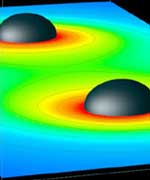
Image credit: Penn State
Scientists at Penn State have reached a new milestone in the effort to model two orbiting black holes, an event expected to spawn strong gravitational waves. “We have discovered a way to model numerically, for the first time, one orbit of two inspiraling black holes,” says Bernd Bruegmann, Associate Professor of Physics and a researcher at Penn State’s Institute for Gravitational Physics and Geometry. Bruegmann’s research is part of a world-wide endeavor to catch the first gravity wave in the act of rolling over the Earth.
A paper describing these simulations will be published in the 28 May 2004 issue of the journal Physical Review Letters. The paper is authored by Bruegmann and two postdoctoral scholars in his group at Penn State, Nina Jansen and Wolfgang Tichy.
Black holes are described by Einstein’s theory of general relativity, which gives a highly accurate description of the gravitational interaction. However, Einstein’s equations are complicated and notoriously hard to solve even numerically. Furthermore, black holes pose their very own problems. Inside each black hole lurks what is known as a space-time singularity. Any object coming too close will be pulled to the center of the black hole without any chance to escape again, and it will experience enormous gravitational forces that rip it apart.
“When we model these extreme conditions on the computer, we find that the black holes want to devour and to tear apart the numerical grid of points that we use to approximate the black holes,” Bruegmann says. “A single black hole is already difficult to model, but two black holes in the final stages of their inspiral are vastly more difficult because of the highly non-linear dynamics of Einstein’s theory.” Computer simulations of black hole binaries tend to go unstable and crash after a finite time, which used to be significantly shorter than the time required for one orbit.
“The technique we have developed is based on a grid that moves along with the black holes, minimizing their motion and distortion, and buying us enough time for them to complete one spiraling orbit around each other before the computer simulation crashes,” Bruegmann says. He offers an analogy to illustrate the “co-moving grid” strategy: “If you are standing outside a carousel and you want to watch one person, you have to keep moving your head to keep watching him as he circles. But if you are standing on the carousel, you have to look in only one direction because that person no longer moves in relation to you, although you both are going around in circles.”
The construction of a co-moving grid is an important innovation of Bruegmann’s work. While not a new idea to physicists, it is a challenge to make it work with two black holes. The researchers also added a feedback mechanism to make adjustments dynamically as the black holes evolve. The result is an elaborate scheme that actually works for two black holes for about one orbit of the spiraling motion.
“While modelling black hole interactions and gravitational waves is a very difficult project, Professor Bruegmann’s result gives a good view of how we may finally succeed in this simulation effort,” says Richard Matzner, Professor at the University of Texas at Austin and principal investigator of the National Science Foundation’s former Binary Black Hole Grand Challenge Alliance that laid much of the groundwork for numerical relativity in the 90’s.
Abhay Ashtekar, Eberly Professor of Physics and Director of the Institute for Gravitational Physics and Geometry, adds, “The recent simulation of Professor Bruegmann’s group is a landmark because it opens the door to performing numerical analysis of a variety of black hole collisions which are among the most interesting events for gravitational wave astronomy.”
This research was funded by grants from the National Science Foundation including one to the Frontier Center for Gravitational Wave Physics established by the National Science Foundation in the Penn State Institute for Gravitational Physics and Geometry.
Original Source: Penn State News Release
